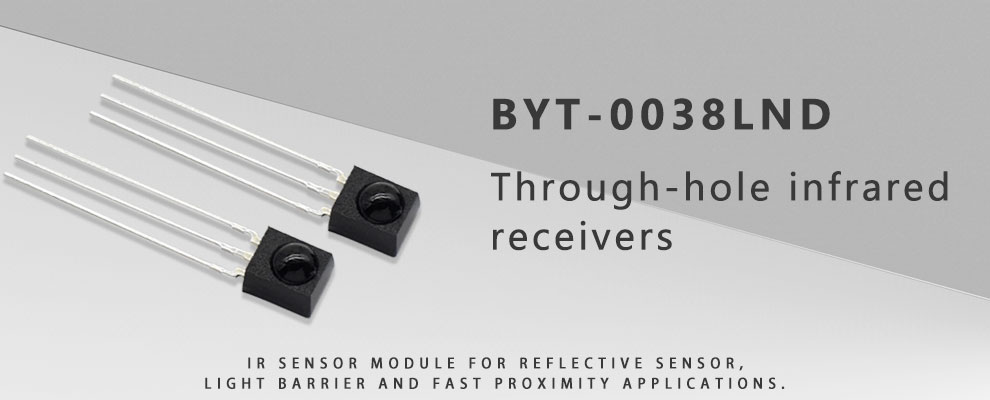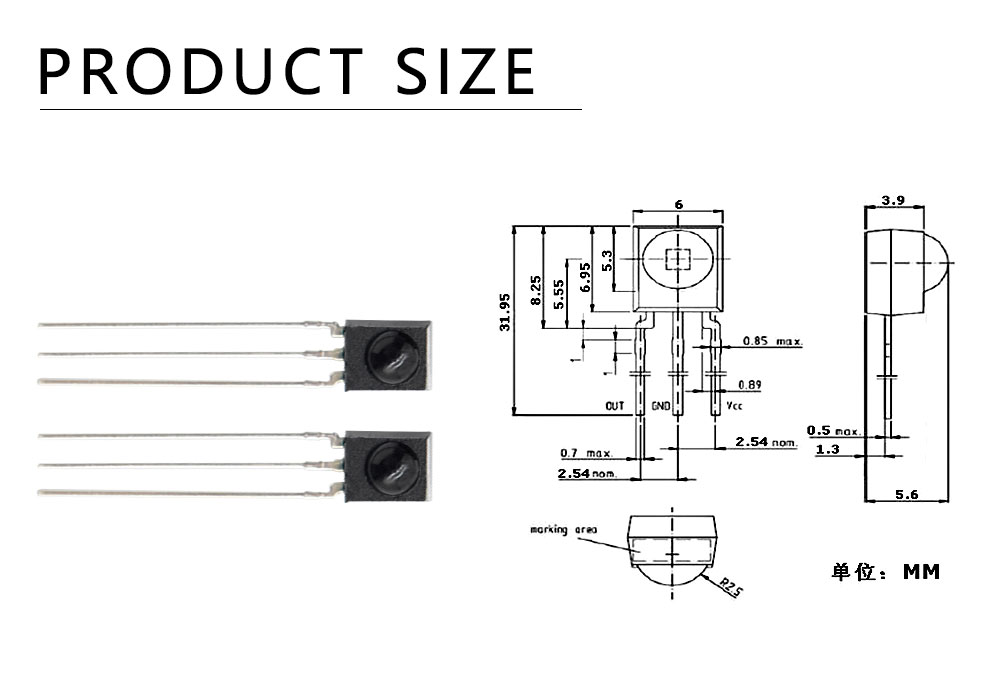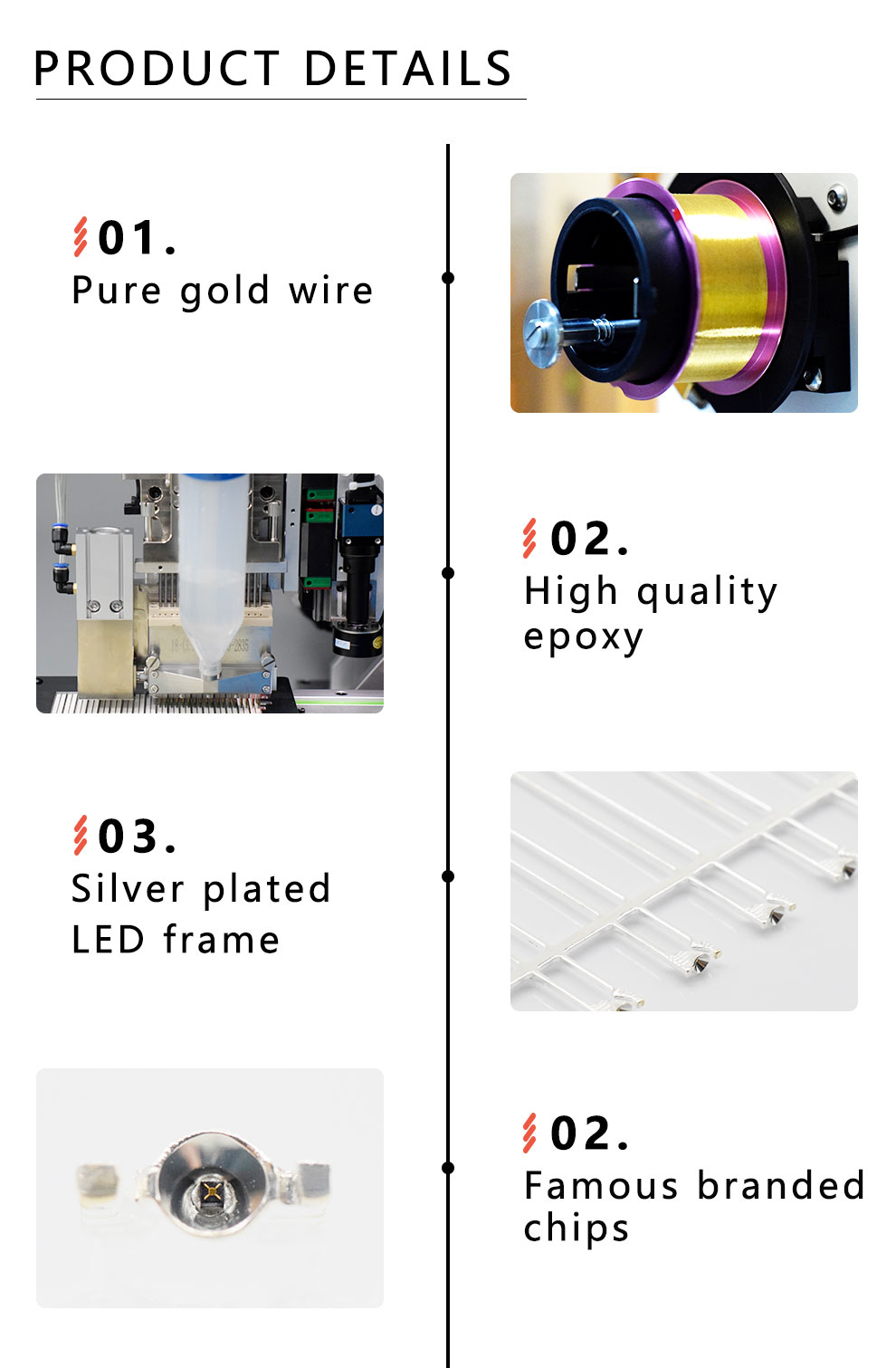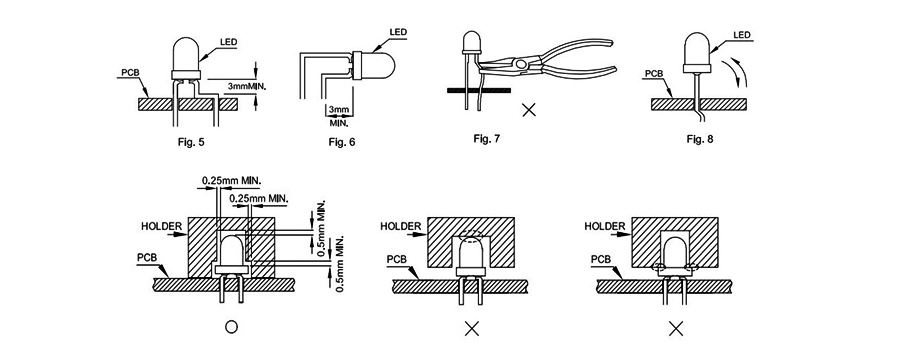Video
1 / 5
IR Receiver for Light Barrier Side View Through-hole
| Model No. : | BYT-0038LND |
|---|---|
| Brand Name : | Best LED |
| Matched product : | Tssp4038 |
Shenzhen, Guangdong, China
- Manufacturer
- Gold Supplier

- Platform Certification

- SGS Certification
- The Belt And Road
- Video

Product description
Infrared receiver with black lens and through-hole type;
Infrared receiver also name with IR receiver as short name. There have kinds of package shape for the IR receiver, normally we can devided into two categories: SMD type and Through-hole type. For this BYT-0038LND, we produce it with through-hole type and black lens. Compare with common 5mm through-hole LED type, this BYT-0038LND looks like a rectangle and 5mm Through-hole LED Lamps will be like a cylindrical with a round top. In order to make this receiver got a better performance during it's working, we make a little domed round top on the middle of rectangle shape. If you were working on some light barrier, fast proximity application or reflective sensor, just feel free to contact us for more detail about this BYT-0038LND. This Infrared receiver will be much perfect for some IR system, security and pet gates, robotics. If you think this infrared receiver are not easy to found in our life, then you will be totally wrong. Just check around your toilet flush, water faucets or soap dispensers ect, you will realise that IR receiver are everywhere~

Size of BYT-0038LND:

Electrical Optical Chararcteristics(Tc=25℃)
Vcc=5V
Vcc=3V
1.0
0.9
1.5
1.5
Vcc=5V
Vcc=3V
4.7
2.7
5.0
3.0
*This IR receiver are availble to received the signal from 940nm LED, 850nm LED or some other IR LED like 810nm LED ect.
Paramete
Symbol
Condition
Min.
Typ.
Max.
Units
Supply Voltge Range
Vcc
2.7
5.5
V
Arrival Distance
L
L5IR=300mA
15
20
m
B.P.F Center Frequency
F0
38
KHZ
Reveiving angle
2θ1/2
70
deg
B.M.P Width
fBW
3.5
6
8.5
KHZ
Current Consumption
Icc
mA
Low Level Output Width
Vol
Isink=2.0mA
0.2
0.4
V
High Level Output Width
Voh
V
Peak Wavelength
λp
940
nm
Low Level Output Pulse Width
Tpwl
Vin=500u Vp-p
500
600
700
ns
High Level Output Pulse Width
Tpwh
Vin=50m Vp-p
500
600
700
ns
Are you still confused how this IR Receiver work? There are a simple picture as follow to explain how it can work:

Material of IR Receiver:
Same as some other thoruhg-hole LED or receiver. We also produce this product with high quality epoxy and pure gold wire;

Storage conditions
1. avoid continued exposure to the condensing moisture environment and keep the product away from rapid transitions in ambient temperature;
2. LEDs should be stored with temperature ≤30℃ and relative humidity<60%℃;
3. Product in the original sealed package is recommended to be assembled within 72 hours of opening;
4. Product in opened package for more than a week should be baked for 6-8 hours at 85-10℃;
LED MOUNTING METHOD
1, The lead pitch of the LED must match the pitch of the mounting holes on the PCB during component placement;
Lead-forming may be required to insure the lead pitch matches the hole pitch;
Refer to the figure below for proper lead forming procedures;
Do not route PCB trace in the contact area between the leadframe and the PCB to prevent short-circuits;

2. When soldering wires to the LED, each wire joint should be separately insulated with heat-shrink tube to prevent short-circuit contact.
Do not bundle both wires in one heat shrink tube to avoid pinching the LED leads;
Pinching stress on the led leads may damage the internal structures and cause failure;

3. Use stand-offs(Fig 3)or spacers(Fig 4)to securely position the LED above the PCB;
4. Maintain a minimum of 3mm clearance between the base of the LED lens and the first lead bend (Fig. 5. Fig. 6)
5.During lead forming, use tools or jigs to hold the leads securely so that the bending force will not be transmitted to the LED lens and its internal structures;
Do not perform lead forming once the component has been mounted onto the PCB;

Lead Forming Procedures
1. Lead Forming Procedures;
2. Do not bend the leads more than twice (Fig. 7);
3. During soldering, component covers and holders should leave clearance to avoid placing damaging stress on the LED during soldering(Fig 8);
4. The tip of the soldering iron should never touch the lens epoxy;
5. Through-hole LEDs are incompatible with reflow soldering;
6. If the LED will undergo multiple soldering passes or face other processes where the part may be subjected to intense heat please check with Best LED for compatibility;

Video
Shenzhen, Guangdong, China
- Manufacturer
- Gold Supplier

- Platform Certification

- SGS Certification
- The Belt And Road
- Video
Send your inquiry to this supplier






















